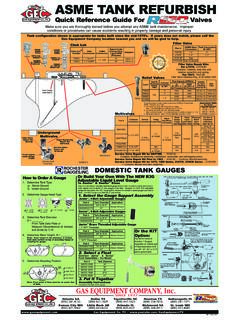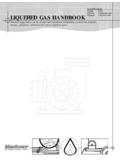Transcription of Safety Warning — LP-Gas Pressure Relief Valves
1 RegO Pressure Relief Valves & Relief Valve Manifolds Safety Warning LP-Gas Pressure Relief Valves Purpose In its continuing quest for Safety , REGO is publishing Safety Warning bulletins explaining the hazards associated with the ! Warning . use, misuse and aging of REGO Products. LP-Gas dealer managers and service personnel must realize that the failure to exercise the utmost care and attention in the installation, inspection and maintenance of these products can result in personal injury and property damage. Relief Valves The National Fire Protection Association Pamphlet #58 - 2004. What You Must Do: Pressure Edition, Liquified Petroleum Gas Code states in Section that, persons who transfer liquid LP-Gas , who are employed to transport LP-Gas , or whose primary duties fall within the Read This Entire Warning scope of this code shall be trained in proper handling proce- dures.
2 Refresher training shall be provided at least every three Install Properly years. The training shall be documented. REGO Warning Bulletins are useful in training new employees and reminding Inspect Regularly older employees of potential hazards. This Warning Bulletin should be provided to all purchasers of REGO and all personnel using or servicing these products. Additional copies are available from REGO and your Authorized REGO Distributor. Scope This bulletin applies to Pressure Relief Valves installed on sta- tionary, portable and cargo containers and piping systems uti- warnings should be as brief as possible. If there is a simple lized with these containers. This bulletin is not intended to be Warning , it is: an exhaustive treatment of this subject and does not cover all Safety practices that should be followed in the installation and Inspect Pressure Relief Valves regularly.
3 Replace unsafe or sus- maintenance of LP-Gas systems. Each LP-Gas employee pect Valves immediately. Use common sense. should be provided with a copy of NPGA Safety Pamphlet 306. LP-Gas Regulator and Valve Inspection and Maintenance . as well as the NPGA LP-Gas Training Guidebooks relating to this subject. 44. RegO Pressure Relief Valves & Relief Valve Manifolds Inspect Regularly 4. Physical damage. Ice accumulations and improper installa- A Pressure Relief valve discharges when some extraordinary tion could cause mechanical damage. IF THERE ARE ANY. circumstance causes an over Pressure condition in the con- INDICATIONS OF DAMAGE, REPLACE THE VALVE. tainer. If a Pressure Relief valve is known to have discharged, the Relief valve, as well as the entire system, should be imme- 5. Tampering or readjustment. Pressure Relief Valves are diately and thoroughly inspected to determine the reason for factory set to discharge at specified pressures.
4 IF THERE. the discharge. In the case of discharge due to fire, the valve ARE ANY INDICATIONS OF TAMPERING OR READ- should be removed from service and replaced. JUSTMENT, REPLACE THE VALVE. 6. Seat leakage. Check for leaks in the seating area using a Relief Valves should be inspected each time the container is noncorrosive leak detection solution. REPLACE THE. filled but no less than once a year. If there is any doubt about VALVE IF THERE IS ANY INDICATION OF LEAKAGE. the condition of the valve, it must be replaced. Never force a Relief valve closed and continue to leave it in Relief Valves service. This could result in damage to the valve and pos- Pressure Eye protection must be worn when performing inspection on sible rupture of the container or piping on which the valve is Relief Valves under Pressure . Never look directly into a Relief installed. valve under Pressure or place any part of your body where the Relief valve discharge could impact it.
5 In some cases a 7. Corrosion and contamination. REPLACE THE VALVE. flashlight and a small mirror are suggested to assist when IF THERE ARE ANY SIGNS OF CORROSION OR CONT- making visual inspections. AMINATION ON THE VALVE. To Properly Inspect A Pressure Relief Valve, Check For: 8. Moisture, foreign particles or contaminants in the 1. A rain cap. Check protective cap located in valve or at end material such as paint, tar or ice in Relief of pipeaway for a secure fit. Protective caps help protect valve parts can impair the proper functioning of the Valves . the Relief valve against possible malfunction caused by rain, Grease placed in the valve body may harden over time or sleet, snow, ice, sand, dirt , pebbles, insects, other debris collect contaminants, thereby impairing the proper opera- and contamination. REPLACE DAMAGED OR MISSING tion of the Relief valve. DO NOT PLACE GREASE IN THE.
6 CAPS AT ONCE AND KEEP A CAP IN PLACE AT ALL VALVE BODY, REPLACE THE VALVE IF THERE ARE. TIMES ANY INDICATIONS OF MOISTURE OR FOREIGN MAT- TER IN THE VALVE. 2. Open weep holes. Dirt, ice, paint and other foreign parti- cles can prevent proper drainage from the valve body. IF 9. Corrosion or leakage at container connection. Check con- THE WEEP HOLES CANNOT BE CLEARED, REPLACE tainer to valve connection with a non-corrosive leak detection THE VALVE. solution. REPLACE THE VALVE IF THERE IS ANY INDICA- TION OF CORROSION OR LEAKAGE AT THE CONNEC- 3. Deterioration and corrosion on Relief valve spring. TION BETWEEN THE VALVE AND CONTAINER. Exposure to high concentrations of water, salt, industrial pollutants, chemicals and roadway contaminants could cause metal parts to fail. IF THE COATING ON THE CAUTION: Never plug the outlet of a Pressure Relief valve. Relief VALVE SPRING IS CRACKED OR CHIPPED, Any device used to stop the flow of a properly operating pres- REPLACE THE VALVE.
7 Sure Relief valve that is venting an overfilled or overpressurized container - raises serious Safety concerns! Replace Pressure Relief Valves In 10 Years Or Less Warning : Under normal conditions, the useful safe service life The safe useful life of Pressure Relief Valves can vary greatly of a Pressure Relief valve is 10 years from the original date of depending on the environment in which they live. manufacture. However, the safe useful life of the valve may be shortened and replacement required in less than 10 years Relief Valves are required to function under widely varying condi- depending on the environment in which the valve lives. tions. Corrosion, aging of the resilient seat disc and friction all pro- Inspection and maintenance of Pressure Relief Valves is very ceed at different rates depending upon the nature of the specific important. Failure to properly inspect and maintain Pressure Relief environment and application.
8 Gas impurities, product misuse and Valves could result in personal injuries or property damage. improper installations can shorten the safe life of a Relief valve. For Additional Information Read: Predicting the safe useful life of a Relief valve obviously is not an exact science. The conditions to which the valve is subjected will 1. CGA Pamphlet Pressure Relief Standards - Cylinders, Section vary widely and will determine its useful life. In matters of this kind, only basic guidelines can be suggested. For example, the 2. REGO Catalog L-500. Compressed Gas Association Pamphlet Pressure Relief Device Standards Cylinders, section requires all cylin- 3. REGO Warning # 8545-500. ders used in industrial motor fuel service to have the cylinder's Pressure Relief Valves replaced by new or unused Relief Valves 4. NPGA Safety Pamphlet 306 LP-Gas Regulator and Valve within twelve years of the date of manufacture of cylinder and Inspection and Maintenance and LP-Gas Training Guidebooks.
9 Within each ten years thereafter. The LP-Gas dealer must observe and determine the safe useful life of Relief Valves in his 5. NFPA # 58, Storage and Handling of Liquefied Petroleum Gases . territory. The valve manufacturer can only make recommenda- 6. NFPA # 59, LP-Gases at Utility Gas Plants . tions for the continuing Safety of the industry. 7. ANSI Safety Requirements for Storage and Handling of Anhydrous Ammonia. 45. RegO Pressure Relief Valves & Relief Valve Manifolds Requirements for Pressure Relief Valves The reasons for this are two-fold: Every container used for storing or hauling LP-Gas and anhydrous If the Relief valve is called upon to open, the resulting dis- ammonia must be protected by a Pressure Relief valve. These charge produces an increased vaporization of the product Valves must guard against the development of hazardous condi- in the container with the result that the liquid cools to a tions which might be created by any of the following: certain extent and the vapor Pressure drops.
10 A reading taken at this time would obviously not indicate what the Hydrostatic pressures due to overfilling or the trapping of Pressure was when the Relief valve opened. liquid between two points. High pressures resulting from exposure of the container to The Pressure gauges usually on most containers provide excessive external heat. somewhat approximate readings and are not intended to provide an indication of Pressure sufficiently accurate to High pressures due to the use of incorrect fuel. judge the setting of the Relief valve. Relief Valves Pressure High pressures due to improper purging of the container. Repair and Testing Consult NFPA Pamphlet #58 for LP-Gas and ANSI # for RegO Pressure Relief Valves are tested and listed by anhydrous ammonia, and/or any applicable regulations governing Underwriters Laboratories, Inc., in accordance with NFPA. the application and use of Pressure Relief Valves .













